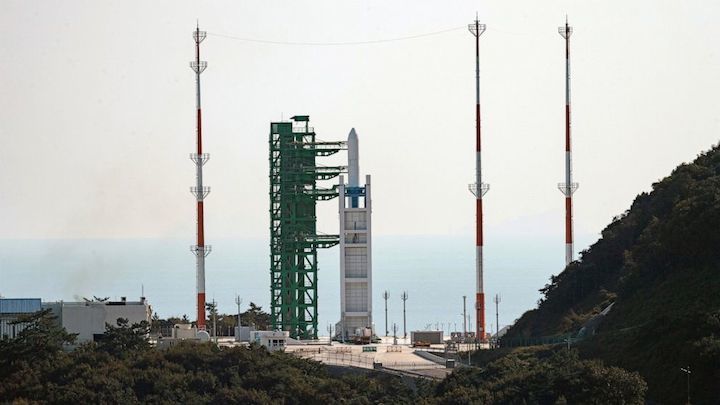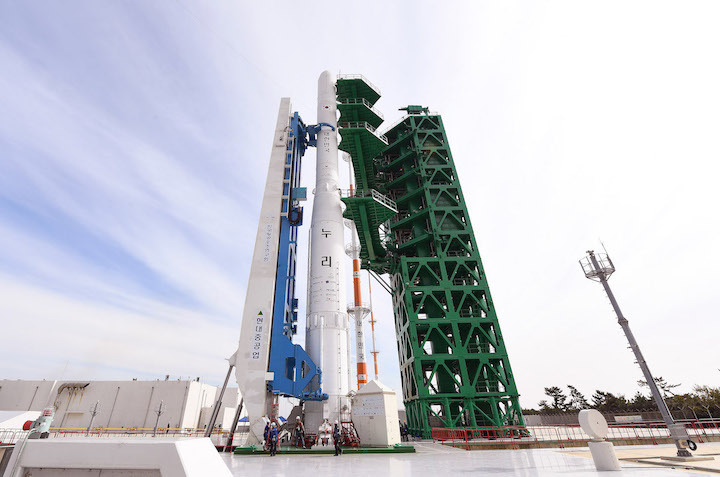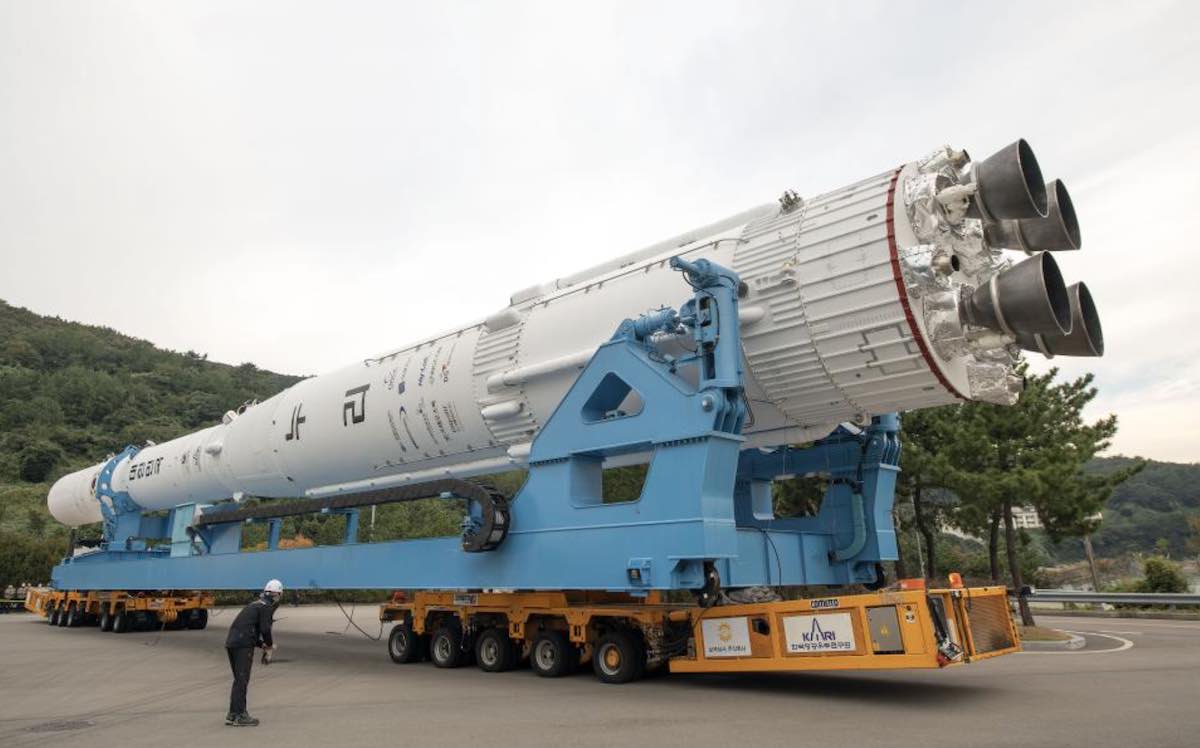22.10.2021
South Korea’s first domestically produced space rocket reached its desired altitude but failed to deliver a dummy payload into orbit in its first test launch on Thursday

SEOUL, South Korea -- South Korea’s first domestically produced space rocket reached its desired altitude but failed to deliver a dummy payload into orbit in its first test launch on Thursday.
South Korean President Moon Jae-in, who observed the launch on-site, still described the test as an “excellent accomplishment” that takes the country a step further in its pursuit of a satellite launch program.
Live footage showed the 47-meter (154 foot) rocket soaring into the air with bright yellow flames shooting out of its engines following blastoff at Naro Space Center, the country’s lone spaceport, on a small island off its southern coast.
Lim Hye-sook, the country’s science minister, said Nuri’s first and second stages separated properly and that the third stage ejected the payload – a 1.5-ton block of stainless steel and aluminum – at 700 kilometers (435 miles) above Earth.
But she said launch data suggested that the third stage’s engine burned out early after 475 seconds, about 50 seconds shorter than planned, failing to provide the payload with enough speed to stabilize in orbit.
Officials from the Korea Aerospace Research Institute, the country’s space agency, said debris from the payload would have landed somewhere in waters south of Australia. The institute was planning to form an inspection committee soon to analyze what went wrong and map out adjustments before the rocket’s next test launch.
The launch, which took place at 5 p.m. (0800 GMT), had been delayed by an hour because engineers needed more time to examine the rocket’s valves. There had also been concerns that strong winds and other conditions would pose challenges for a successful launch.
“Although (the launch) failed to achieve its objectives perfectly, it was an excellent accomplishment for a first launch,” Moon said in a televised speech.
“The separations of the rockets, fairings (covering the payload) and the dummy satellite worked smoothly. All this was done based on technology that is completely ours,” he added.
After relying on other countries to launch its satellites since the early 1990s, South Korea is now trying to become the 10th nation to send a satellite into space with its own technology.
Officials say such an ability would be crucial for the country’s space ambitions, which include plans for sending more advanced communications satellites and acquiring its own military intelligence satellites. The country is also hoping to send a probe to the moon by 2030.
Nuri is the country’s first space launch vehicle built entirely with domestic technology. The three-stage rocket is powered by five 75-ton class rocket engines placed in its first and second stages. It is designed to deliver a 1.5-ton payload into orbit 600 to 800 kilometers (372 to 497 miles) above Earth.
“The launch left some frustration, but it's meaningful that we confirmed we have obtained core technology” for space launches, said Lim, the minister.
Scientists and engineers at KARI plan to test Nuri several more times, including conducting another launch with a dummy device in May 2022, before trying with a real satellite.
South Korea had previously launched a space launch vehicle from the Naro spaceport in 2013, which was a two-stage rocket built mainly with Russian technology. That launch came after years of delays and consecutive failures. The rocket, named Naro, reached the desired altitude during its first test in 2009 but failed to eject a satellite into orbit, and then exploded shortly after takeoff during its second test in 2010.
It wasn’t clear how North Korea, which had been accused of using its space launch attempts in past years as a disguise for developing long-range missile technology, would react to Thursday’s launch.
While pushing to expand its nuclear and missile program, the North had shown sensitivity about South Korea’s increasing defense spending and efforts to build more powerful conventionally armed missiles.
In a speech to Pyongyang’s rubber-stamp parliament last month, North Korean leader Kim Jong Un accused the U.S. and South Korea of “destroying the stability and balance” in the region with their allied military activities and a U.S.-led “excessive arms buildup” in the South.
While Nuri is powered by liquid propellants that need to be fueled shortly before launch, the South Koreans plan to develop a solid-fuel space launch rocket by 2024, which could be cheaper to build and prepared for launch more quickly. Such rockets would also be ideal for more sensitive space launches, including those involving military intelligence satellites.
South Korea’s space ambitions received a boost in recent years as the Trump and Biden administrations took steps to ease decades-long U.S. restrictions that capped Seoul’s missile development before eventually allowing its ally to build conventional weapons with unlimited range and warhead weight. In easing the so-called missile guidelines, the U.S. also removed a limit on how powerful South Korea's solid-fuel rockets can be for space launch purposes.
South Korea currently has no military surveillance satellites of its own, which leaves it relying on U.S. spy satellites to monitor North Korea. Officials have expressed hopes of launching domestically developed, low-orbit military surveillance satellites using the country’s own solid-fuel rockets in the next several years.
Quelle: abcNews
+++
South Korean satellite launcher set for first test flight

South Korea’s new three-stage, liquid-fueled Nuri launcher is scheduled to blast off Thursday on the country’s first attempt to place an object into orbit with an entirely homegrown rocket.
The launch Thursday is the culmination of a nearly 12-year, $1.7 billion development program to give South Korea a domestic satellite launch capability. South Korea’s space agency, the Korea Aerospace Research Institute, led the effort to design, build, and test the Nuri rocket.
Liftoff is scheduled for 4 a.m. EDT (0800 GMT) from the Naro Space Center, a spaceport around 300 miles (500 kilometers) south of Seoul. Korean officials delayed the launch one hour early Thursday.
“Nuri is our country’s own space launch vehicle that has been developed through the blood, sweat, and tears of many researchers and industrial parties since 2010, and I believe its launch this October will mark a milestone in the history of our space development,” said Lim Hye-sook, South Korea’s science minister, in a statement.
“Since it is an important period ahead of the launch, the government will also provide active support so that researchers can do their best and concentrate on research and development with a calm mind until the last moment,” she said.
The Nuri rocket, also known as the KSLV 2, will aim to deliver a satellite mock-up to a polar orbit around 435 miles (700 kilometers) above Earth after launch Thursday. KARI officials have given the test launch just a 30% chance of success, according to the Korea Herald, the country’s largest English-language newspaper.
Ground crews transferred the rocket from its assembly hangar to its launch pad Wednesday. The nearly 155-foot-tall (47.2-meter) rocket was raised vertical in preparation for the multi-hour countdown.
Before liftoff, the South Korean launch team will load kerosene and liquid oxygen propellants into all three stages of the Nuri rocket.
Four KRE-075 engines, developed by the South Korean company Hanwha Aerospace, will flash to life in the final moments of the countdown. The liquid-fueled engines will power up to full throttle, generating 586,000 pounds of thrust to push the launcher into the sky.
The rocket’s KRE-075 engines each use a gas generator to drive a pump feeding propellant into the thrust chamber. SpaceX’s Merlin engine, which power the Falcon 9 rocket, use a similar design.
The Nuri rocket’s second stage has a single KRE-075 engine with a vacuum expansion nozzle. The launcher’s third stage, which fires to inject payloads into orbit, is powered by a smaller engine producing about 15,000 pounds of thrust.
Heading south from the Naro Space Center, the Nuri rocket will exceed the speed of sound in less than a minute before climbing through the stratosphere. Here is an overview of the launch sequence:
• T+00:55: Mach 1
• T+02:07: Stage 1 Separation
• T+03:53: Fairing Separation
• T+04:34: Stage 2 Separation
• T+13:18: Stage 3 Shutdown
• T+16:07: Payload Separation
The launch of South Korea’s first Nuri rocket comes nearly nine years after the only successful launch of the Naro 1 booster. South Korea launched three Naro 1 rockets from the Naro Space Center, but the first two flights in 2009 and 2010 failed shortly after liftoff.
The third Naro 1 mission Jan. 30, 2013, successfully deployed a small South Korean technology demonstration satellite into orbit, making South Korea the 11th country to launch its own satellite into orbit, but the feat was not accomplished without international help.

Russia’s space contractor Khrunichev developed the Naro 1’s first stage, and the booster’s kerosene-fueled RD-151 main engine was built by NPO Energomash, another Russian company.
Korea Aerospace Industries led the South Korean industrial team responsible for developing the Nuri rocket.
South Korea’s space industry has grown in the last decade with the advancement of the country’s domestic satellite manufacturing base. The first two geostationary satellites built in South Korea launched in 2018 and 2020 on weather monitoring and oceanography missions.
The Korea Pathfinder Lunar Orbiter is scheduled to launch in 2022 on a SpaceX Falcon 9 rocket. The spacecraft is being manufactured in South Korea, and will carry a payload of Korean and U.S. science instruments to study the moon.
KARI also has a roadmap to develop a bigger satellite launcher after debuting the Nuri rocket.

The Nuri, which means “world” in Korean, is designed to place a payload of up to 3,300 pounds (1,500 kilograms) into an orbit more than 372 miles (600 kilometers) in altitude.
South Korean officials plan to launch the second Nuri rocket next May. That mission will be the first Nuri flight to carry a real satellite into orbit.
Quelle: SN
